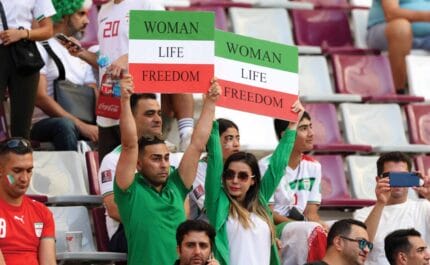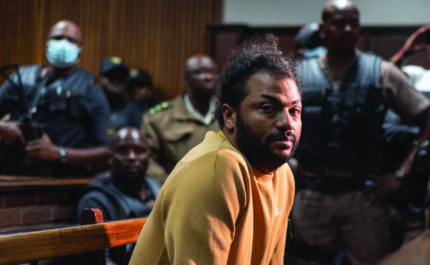From the wreckage
On 17th July 2014, a Malaysian Airlines flight en route from Amsterdam to Kuala Lumpur was brought down in eastern Ukraine. Almost six years later a trial against the alleged perpetrators finally began on 9th March 2020. Harriet Salem, who was one of the first people at the scene of the crash, tells the story of the long hunt for justice
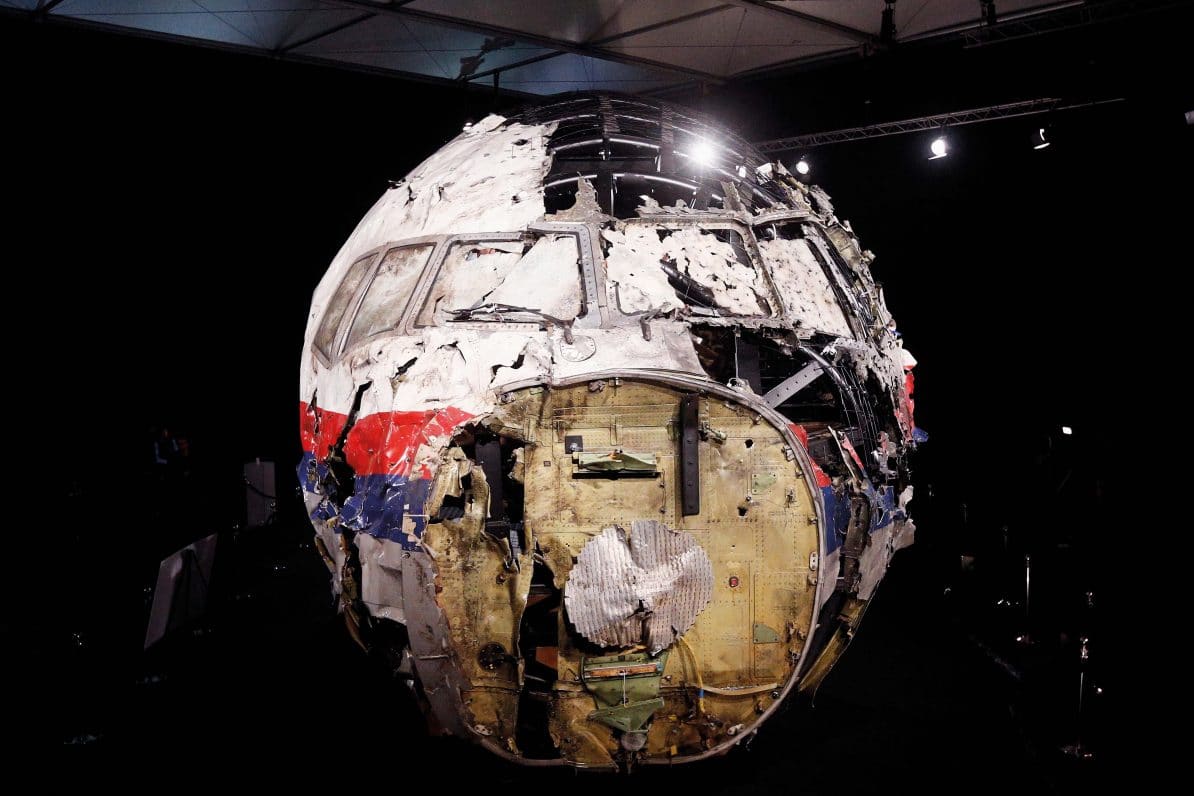
The wreckage of flight MH17 at the Gilze-Rijen military base in the Netherlands, 13th October 2015. Photo: Dean Mouhtaropoulos/Getty Images
9th March 2020 (Taken from: #38)
The squat, square buildings of the Schiphol Judicial Complex occupy an unremarkable corner of a nondescript industrial estate near Amsterdam’s airport. This drab landscape of grey car parks and concrete under a leaden sky provides a strange backdrop to the dramatic, highly unusual court case I’ve come to see.
The trial of four men accused of downing flight MH17 and killing all 298 people onboard is about to start. Although the case is being heard in the Netherlands and under Dutch law, the alleged crime took place hundreds of miles away in skies above east Ukraine. If convicted, the accused will be the most prolific mass murderers ever to be sentenced by a Dutch court. Yet they are unlikely to spend a single day in prison – at least while Vladimir Putin maintains his grip on power in Russia.
As well as sparking a five-year-long investigation by dozens of law-enforcement officials across the globe, the destruction of flight MH17 also attracted the attention of amateur internet sleuths. It was they who first proved that a Russian Buk surface-to-air missile was used to shoot down the airliner. For many, the accused’s ties to the Russian military and intelligence services mean that the trial’s outcome will also be a verdict on Moscow’s covert military operations in east Ukraine.
At the courthouse the four judges who will oversee the case, which is expected to last at least a year, have taken their seats. To their left sit the prosecution and in front of them are the defence lawyers. Normally the defendants would also be present. However, in this case the four men accused of bringing down MH17 while fighting with separatist forces in east Ukraine – Russians Sergey Dubinskiy, Oleg Pulatov and Igor Girkin and Ukrainian Leonid Kharchenko – are absent.
Also missing are the press, the public and victims’ relatives. Because of their sheer number and the security concerns that surround this high-profile case, they will watch proceedings via a livestream in separate rooms, as will I.
“A lot of people have waited a long time for this day,” begins judge Hendrik Steenhuis. “This tragic loss of so many lives has touched many all over the world… The manner in which they so abruptly ended is barely conceivable.”
Nearly six years after flight MH17 came down, the trial has begun.
It’s not just the infamy or legal peculiarities of the case that have brought me to this courthouse. It’s also personal interest. On 17th July 2014, I was among the first reporters at the crash site of MH17.
It had been a tumultuous and bloody year for Ukraine. In February, protests against pro-Russian president Viktor Yanukovych had turned the country’s capital into a quasi-warzone. Demonstrators, camped out in sub-zero temperatures on Kyiv’s central Independence Square, boiled with rage over the president’s withdrawal from a trade deal with the European Union. Protesters hurled Molotov cocktails. Government snipers, perched on rooftops, shot at the crowds below. At least 112 people were killed – later they would be honoured as martyrs and dubbed the ‘Heavenly Hundred’.
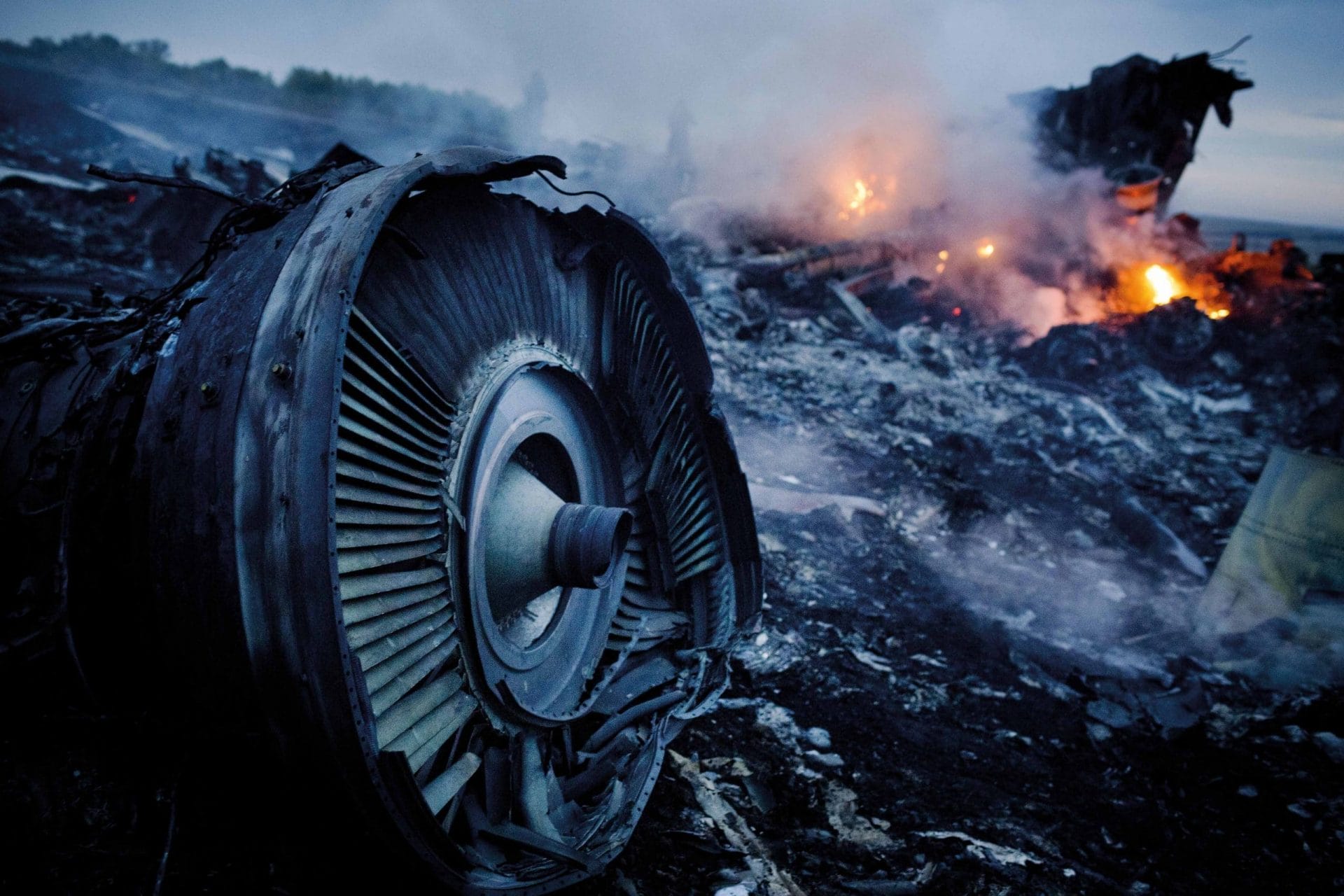
Debris from the downed plane smoulders in a field in Hrabove in the Donetsk province, 17th July 2014. Photo: Piero Quaranta/AFP via Getty Images
Yanukovych fled the country shortly thereafter, but the trouble was only just beginning. With Ukraine’s new post-revolution government on the back foot, the infamous “little green men” – Russian soldiers without insignias on their uniforms – popped up in Crimea. Within weeks, the Kremlin announced it was annexing the territory.
With the front line shifting daily and civilians still adapting to their new reality, the death toll in Ukraine rose quickly”
Ukrainians had little time to mourn the loss of Crimea’s faded but much-loved Soviet-era tourist resorts, however. Storm clouds were already gathering on another front. Across Donbas, Ukraine’s easternmost region, pro-Russian separatist militias had seized local government buildings and declared independence as the Luhansk and Donetsk ‘People’s Republics’.

Anti-government protesters clash with police in Kyiv in February 2014. Photo: Pierre Crom/Getty Images
I followed the story, travelling from Kyiv to Crimea then on to Donbas. By the time summer came, the sight of convoys of tanks and armoured personnel carriers disappearing into a yellow sea of sunflower fields had become a familiar sight in east Ukraine. So too had the crumpled remains of buildings that dotted the landscape, and the charred bodies inside. With the front line shifting daily and civilians still adapting to their new reality, the death toll rose quickly in those early months of war. The UN estimated that between June and September around 8,000 people died in the fighting.
When word filtered through to reporters in the early evening of 17th July that a plane had been shot down, I was having dinner on the terrace of the Donetsk Ramada, one of the few hotels to remain open during the war. It was hardly surprising news. Control of airspace had become a major front in the conflict. In recent weeks I had reported from the wreckage of three downed Ukrainian SU-25 combat planes. It was in the skies that the Ukrainian military, depleted by years of chronic under-investment, still had the edge over the ragtag, Russia-backed militias they were fighting in Donbas. Although Moscow was covertly sending a steady stream of weapons and men across the border to aid the separatists, it could not provide them with planes while still maintaining a façade of plausible deniability. So Ukraine used its advantage and dropped bombs from the air. The separatists struck back with surface-to-air missiles and sent them tumbling to the ground.
None of that prepared me for what I saw on 17th July 2014. After hearing the news of the downed plane I headed out to the crash site with a handful of other journalists. As we approached via a bumpy dirt track in the dimming light, the car’s headlights picked up something in the middle of the road. I stepped out to take a look. It was a severed leg, a mangled mass of flesh on one side, a perfectly preserved foot on the other, its toenails painted bright, postbox red. The air was thick with the smell of burning fuel and in the encroaching darkness I could make out the silhouettes of enormous hunks of still-burning twisted metal. It was immediately clear from their size that this was not a fighter jet but a civilian aircraft.
When we returned the next day, in the light, the true scale of the horror was visible. Plane parts littered the fields; a wing cut majestically through a sea of corn, a crumpled fuselage marked ‘Malaysia Airlines’ sat in a bed of sunflowers, a yellow drop-down mask designed to deliver in-flight oxygen nestled in the dirt.
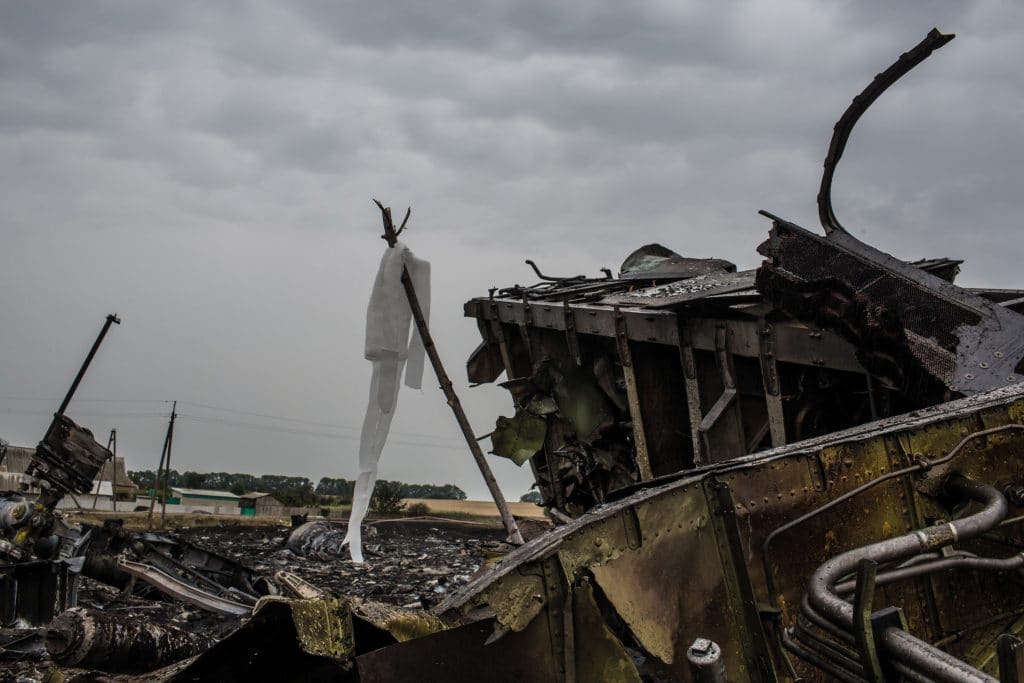
A white flag indicates the presence of human remains at the crash site, 18th July 2014. Photo: Brendan Hoffman/Getty Images
By then volunteers, mostly firemen and miners, had arrived on the scene. Armed with strips of white cloth tied to sticks, they spread out into the fields. Wherever they found human remains they planted a makeshift flag – soon there were dozens dotting the area. Across the site the contents of disgorged suitcases had been scattered far and wide: flip-flops, suntan lotion, a pack of cards, books, children’s toys, jewellery. Amid the carnage were strewn an unlikely menagerie of dead pets from the plane’s hold, including a large St Bernard dog curled up peacefully on the grass and a cage of brightly coloured macaws, beaks agape as if still mid-croak.
The week that followed was relentlessly awful. The separatists, adamant that the Ukrainian armed forces were responsible, refused access to the fields to international emergency responders and aviation experts. The bodies stayed where they were.
One afternoon, a separatist commander, who went by the nom de guerre ‘Grumpy’, gave an impromptu press conference. With a cigarette dangling from his lips and vodka-infused breath, he grabbed a child’s stuffed toy monkey from the debris and warned the gathered journalists that he would “break their legs” if they told “lies” about the separatists shooting down the plane. “Show the world that Ukraine is killing kids,” he said, triumphantly holding the monkey aloft.

A separatist commander known as ‘Grumpy’ brandishes a child’s toy amid the debris of flight MH17. Photo: Harriet Salem
It was hot, with temperatures reaching 35°C, and as the days passed the cloying smell of death and decay around the site grew ever stronger. By the time the remains were wrapped in black bags and loaded onto a train in Torez, the start of their negotiated repatriation to the Netherlands, the stench was overwhelming. As I watched the train doors close, a perfumed scarf wrapped around my face, I felt a tear roll down my cheek – and a deep sense of relief.
It was these scenes that flashed through my mind as silence fell over the courtroom in March 2020 while prosecutor Dedy Woei-a-Tsoi took the stand and began to read out the list of all 298 people killed that day: “Wan Amran Bin Wan Hussin, Choo Jin Leong Eugene, Ahmad Hakimi bin Hanap…” It took her 19 minutes.
When Christo Grozev heard the news that a passenger jet had been shot down over Donbas, he was hundreds of miles away from east Ukraine, on his annual family summer holiday to the Black Sea coast in Bulgaria. For most of his career Grozev had worked in the radio industry, setting up, buying and managing radio stations across Europe. But in 2014 he had started exploring the other side of the media – investigating and reporting. As a self-styled “hobby researcher” he’d begun blogging about Russia’s information war in Ukraine. Moscow’s response to the downing of MH17 immediately piqued his interest. A Kremlin statement laid the blame for the crash squarely at Ukraine’s door: “The state over whose territory this occurred bears responsibility for this awful tragedy,” it read. But the Ukrainian Security Service (SBU) had released a compilation of snippets from tapped phone calls, allegedly between separatist leaders and Russian intelligence operatives, that suggested otherwise.
“How are things going there?” asks one caller, identified by his call sign, ‘Grek’. “We are 100 percent sure it was a civilian plane,” replies codename ‘Major’, who is at the crash site. He says he can’t see any weapons or military paraphernalia among the wreckage, only “civilian belongings”. “Fuck,” continues ‘Major’, “the debris was falling straight into people’s yards.” The calls become increasingly frantic. “There’s a whole lot of bodies of women and children.” Then another call, this time involving ‘Kozitsyn’, the commander of a separatist battalion: “Why the hell were they flying? There’s a war going on.” The recordings pointed to a grim conclusion: the separatists had mistaken the plane for a Ukrainian military aircraft and shot it down.
Investigating MH17 is like doing a jigsaw puzzle but not knowing what the picture is”
Grozev listened to the audio over and over again. Both sides in the war in Donbas were known to use propaganda, sometimes amounting to outright lies. “It was very difficult to know whether these intercepts were real,” he tells me. “So, I set out to establish if these recordings that Ukraine released were true.” His plan was audacious, yet simple. Since he spoke Russian fluently, he would just call the number of ‘Grek’, which had been leaked by the SBU online, using a spoofing service that made it seem he was calling from a Moscow line. He’d also identified what he believed was Grek’s real first name. In a slip of the tongue, one of the callers in the intercepts had addressed him as ‘Sasha’, which is an abbreviation of Alexander in Russian. As Grozev’s family went off to enjoy a day of sun, sea and sand, he set out from the hotel to find some traffic as background noise. If ‘Sasha’ answered he wanted it to sound like he was “calling from a busy Moscow street”.
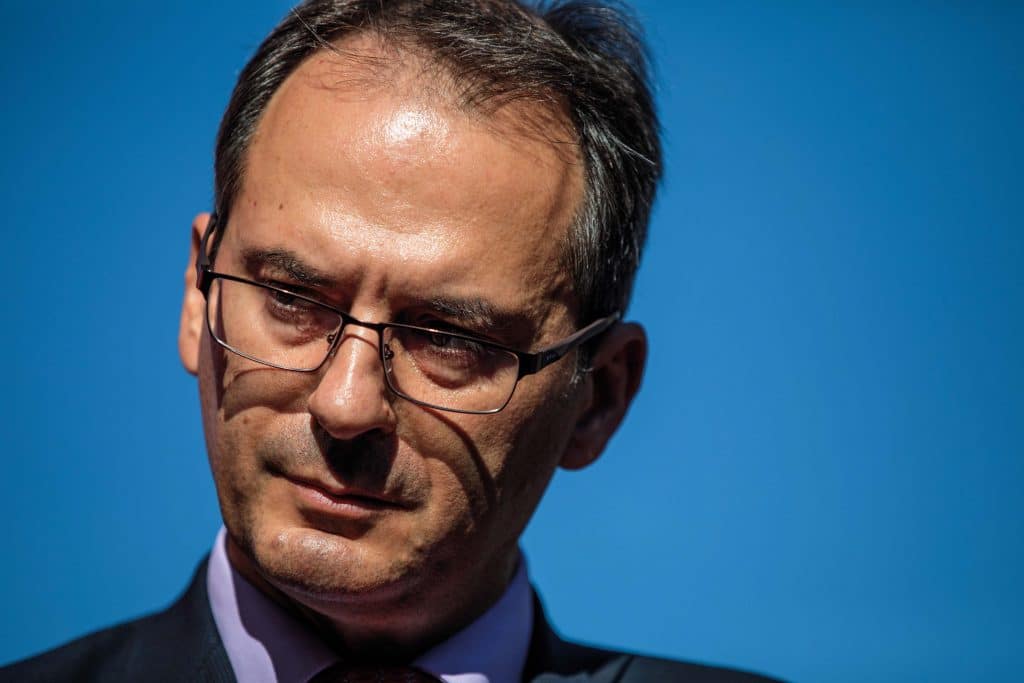
Christo Grozev, Bellingcat’s lead Russia investigator. Photo: Jack Taylor/Getty Images
It was less than 24 hours after MH17 had been downed when Grozev hit the call button. Amazingly his plan worked. ‘Alexander’ not only answered the phone, he agreed to talk briefly. He was clearly caught on the back foot. While he denied that the separatists had shot down a civilian plane, he conceded that parts of the call were probably genuine. He said that he had discussed shooting down a plane, but not that night. It wasn’t an outright admission of guilt, but it was enough for Grozev to know he was on to something. He posted a transcript of the call to his blog. “That,” he tells me over the phone in late April 2020, “was the beginning of the obsession.”
It was through this blog post that Grozev connected with Eliot Higgins. A university drop-out and out-of-work finance and admin worker, Higgins has become an unlikely star in the world of conflict journalism. In 2013, his exposé of an international operation to smuggle arms to opposition rebels in Syria made the front page of The New York Times. But unlike most war reporters Higgins hadn’t donned a flak jacket or dodged bullets on the front line to get his story. Instead, he had conducted the investigation from the sitting room of his family’s modest home in Leicester, UK, spending days trawling jihadis’ YouTube channels, activists’ social media pages and clips of weapons caches on Syrian state television. He’d scoured each post meticulously for clues: an out-of-place weapon, a landscape point that could aid him in geolocating the scene, a slipped face-mask or a shouted name among the background noise that could reveal an identity.
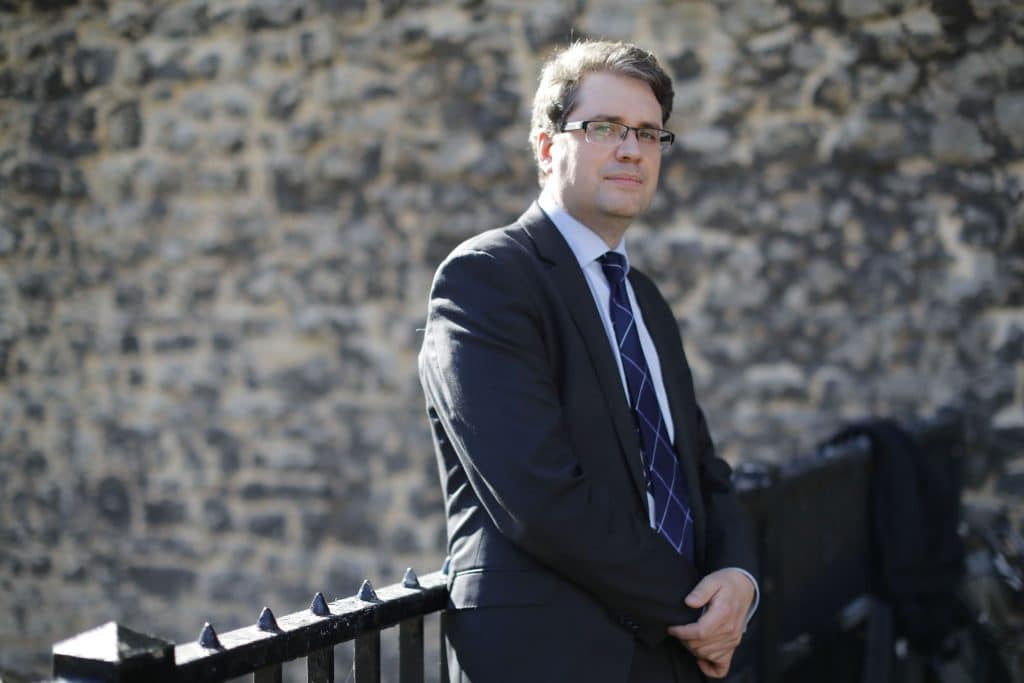
Eliot Higgins, founder of open-source journalism site Bellingcat. Photo: Tolga Akmen/AFP
In the early days, Higgins blogged his findings anonymously under the alias ‘Brown Moses’, a name taken from a Frank Zappa song. His avatar was one of Francis Bacon’s portraits of a screaming pope. But as his work garnered more attention he ditched the alter ego. By 2014, flying high on the success of the Syria investigation, he was out as Eliot Higgins and readying for a new project. To finance it he had set up a crowd-sourced fundraiser under the working title ‘Bellingcat’ – a hat-tip to Aesop’s fable in which mice plot to neutralise a marauding feline by putting a bell around its neck.
I realised the value of the work we were doing… finding new information very quickly”
The project launched on July 15th 2014, and just two days later MH17 came down over east Ukraine. Investigating it seemed a natural step to take. “It was never a specific decision to look into this case. It just happened,” Higgins tells me. “I reacted to it, and others started to look into it too, and we formed this very organic community of like-minded people who were investigating it. I don’t think I really realised how huge the story was, but I realised very quickly the value of the work we were doing because we were finding new, unknown information very quickly.”
Bellingcat’s work, now considered the gold standard of ‘open source’ journalism, made impressive discoveries, incredibly fast. While Western governments were busy bickering with the Kremlin – which has consistently denied any involvement in the war in east Ukraine – about how the separatists had got their hands on a high-powered weapon capable of shooting down a passenger jet flying at 33,000 feet, Bellingcat was busy proving that such a weapon was in the area and, more importantly, exactly where it had come from.
By combing through social media posts and material sent in by ‘citizen journalists’ who had snapped the Buk launch vehicle from their windows as it passed their homes, the researchers were able to sketch out the route the missile system took that fateful day as it was moved to its firing site in some cornfields near the city of Snizhne, east of Donetsk. They were also able to trace its earlier journey across the Russian border into east Ukraine in a convoy of vehicles and soldiers belonging to the 53rd Anti-Aircraft Missile Brigade based in Kursk, Russia.
In Bellingcat’s reports, information is presented in an easy-to-digest format and accompanied by meticulously detailed explanations of how conclusions were reached. There are timelines of the Buk system’s movements, followed by images and maps that show where it was spotted and photographed along its route. Accompanying text explains how the photos were verified: the shadow analyses that pinpoint the time of day, the landmarks that facilitate geolocation, the distinctive low-rider Volvo truck upon which the Buk launcher sits and the covering camouflage netting that, ironically, makes it easily identifiable. There are before and after satellite images of the alleged firing site, where a tell-tale scorched patch of grass appeared the day after the missile was fired. A ‘fingerprint’ analysis graph shows that the unique pattern of damage to the rubber side-skirting of the Buk missile system spotted heading through Donbas is almost identical to the one belonging to the 53rd Air Defence Brigade in Russia.
Sifting through the sheer amount of data available about MH17 takes a lot of time, and investigators often don’t know exactly which clues they’re looking for. Grozev, who is now Bellingcat’s lead Russia investigator, likens it to “doing a jigsaw puzzle but not knowing what the picture is, or if all the pieces even belong to the same puzzle”. It’s one that he estimates he’s spent “thousands of hours, probably tens of thousands,” grappling with.
It is painstaking work. Grozev, who has mostly worked on finding the people involved in bringing down MH17, recalls one particularly challenging case. He was trying to identify a separatist commander going by the call sign ‘Orion’ who could be heard discussing the transportation of a Buk in east Ukraine in the intercepts released by the SBU. The Bellingcat investigators had managed to find just three clues. The first was that ‘Orion’ was also addressed as Andrey Ivanovich, giving investigators a possible first name and a patronymic – a name derived from a paternal first name, which in this case would be ‘Ivan’. The second clue was a birthday greeting, which provided a possible day and month of birth. The third, and most intriguing, was Orion’s distinctive “high-pitched, almost feminine voice”.
Grozev decided to start with the name. Even if it wasn’t real, Russian military intelligence officers often recycle pseudonyms so, he reasoned, it seemed the best clue to start with. Eventually he stumbled on a possible match. Someone going by the name ‘Andrey Ivanovich’ had served as the Minister of Defence in the Russia-backed breakaway republic of South Ossetia (still recognised by most countries as part of Georgia) from 2006 to 2008. Yet, despite the high-profile role, Grozev and his fellow investigators couldn’t find any further concrete evidence of his existence. “That this person who had a high-profile position wasn’t in any government photos, in any newspaper photos, that he had never given an interview with his face or voice on it, we found that to be extremely unusual,” says Grozev. “And, indeed, indicative of a secret assignment.”
Next the Bellingcat investigators searched leaked databases of Russian military personnel. Again, they found a possible match. Andrey Ivanovich Laptev, a suitably high-ranking officer, had the same birthday as ‘Orion’. They felt they were getting closer, but they still needed more proof. Orion’s distinctive voice was the key. “We just needed to hear him speak to know it was him,” says Grozev. But although investigators found several phone numbers associated with Laptev, he never answered their calls.
Weeks went by. Eventually the investigators got lucky. Laptev’s wife answered the house phone. Posing as pollsters, the investigators asked if there were any men aged 50 to 60 in the household. She called out to her husband to see if he would take part in the survey. “No, I would hate to talk to pollsters,” he shouted back. The high-pitched voice was instantly recognisable to the investigators. “The recording of that call was enough to do a forensic comparison of the voice in the SBU intercepts,” says Grozev. “And it was a match… You can say it was the final piece in that particular puzzle.”
Meanwhile in the Netherlands another even bigger investigation was underway. Of the 298 passengers aboard MH17 the majority, 196, were Dutch. The horrific images of holidaymakers’ bodies and possessions strewn across the fields of east Ukraine had sparked an outcry of public grief and anger in the nation. On 24th July 2014, when the victims’ remains finally arrived back in the Netherlands, thousands of people lined the streets to pay their final respects as the black hearses transporting the bodies made their way to a military base in Hilversum. Flags were flown at half-mast and the wings of the country’s iconic windmills were tilted to the right – a historic symbol of mourning. Dutch prime minister Mark Rutte vowed that the perpetrators would “not escape justice”.
To deliver on its promise the Netherlands established the Joint Investigation Team (JIT). Although Dutch-led, it also included law-enforcement officials from 12 cooperating countries across the globe, from Belgium to Australia. Compared to Bellingcat, the team’s resources were vast. Among their number the JIT could count some of the world’s most respected forensic scientists, aviation experts and investigators. The task ahead of them, however, was equally massive. The JIT’s remit was to carry out a criminal investigation into the causes of the plane’s crash. That meant it had to go much further than Bellingcat’s open-source work. The JIT investigators would have to present their conclusions not just to the court of public opinion but to a judge, and would need to prove them beyond reasonable doubt. There was one big obstacle in their way. For all its expertise, the JIT was missing something crucial to any criminal investigation – the scene of the crime itself.

A procession of hearses carries the remains of the victims of the crash from an airbase in Eindhoven to Hilversum in the Netherlands, 24th July 2014. Photo: Remko de Waal/AFP via Getty Images
Normally a crime scene is sealed off by police tape and entry is strictly controlled to avoid cross-contamination. Evidence is carefully collected, bagged and preserved for forensic analysis. In the case of MH17, however, none of this was possible. The plane had come down hundreds of miles away in the middle of a warzone and the separatist groups that controlled the area refused to give the Dutch investigators safe passage to access the site. For the JIT only one option remained: if they couldn’t go to the site they would have to bring it to them.
In November 2014, following some four months of behind-the-scenes negotiations, the JIT announced that a six-day operation was underway to remove the first part of the debris from the site in east Ukraine and transfer it to the Netherlands. It was a mammoth undertaking. Huge sections of the wreckage had to be lifted by crane and transported into Ukrainian-held territory by train before being loaded onto trucks for the remainder of the journey. The largest section of the plane weighed more than 6,000 kilos, while the smallest was under one gram. The wreckage alone filled 12 train carriages. Another 11 shipping containers were filled with the personal effects of the flight’s passengers.
Shuttling the crime scene across Europe, however, was just the first step in an investigation that has now spanned over five years. By the time the crash-site contents made it onto Dutch soil they had already been sitting out in the open for months, exposed to the elements and trampled on by journalists and emergency workers.
The evidence showed that the plane was almost certainly destroyed by a missile”
The forensic experts knew they would have to get creative to find evidence that hadn’t been contaminated and which would stand up in court. They started by cataloguing and photographing every item in the vast warehouse of materials. Each, they decided, would be checked five times by forensic experts to ensure that absolutely nothing was missed. “We had to get the maximum out of it. We went through it with magnifying glasses and tweezers,” Jouke Jonker, a forensic researcher with the JIT, told the investigation’s self-published e-zine. “We got the last mortal remains out of it.”
Among the pieces of evidence examined by the team were the passengers themselves. While X-raying the victims’ bodies they found what would turn out to be a crucial clue: 30 small metal fragments, each measuring less than a cubic centimetre in size. Several of the pieces, believed to be part of the Buk warhead, tested positive for traces of paint and zirconium, a compound used in the cockpit windows of the Boeing 777-200. It was a major breakthrough. The evidence showed that the plane was almost certainly destroyed by a missile that came through its front window and was not, for example, brought down by an explosive device onboard. As the fragments were found inside victims they were also highly unlikely to have been tainted while sitting out in the fields or during transit. It was exactly the type of scientific proof the investigators were looking for to build their case.
Meanwhile, at a military hangar at the Gilze-Rijen air-force base, aviation specialists were working to reassemble the wreckage of the Boeing 777 around a 20m-long metal frame, eventually piecing back together around 35 percent of the original structure. Among their discoveries was another indication of the plane’s fate: a piece of what investigators believed to be part of the missile’s warhead lodged in the cockpit’s window frame. The evidence was mounting, but investigators still needed to prove that the shards they had found belonged to a Buk missile.

A fragment of flight MH17. Photo: Dean Mouhtaropoulos/Getty Images
The only way to do that definitively was to test-fire a Buk and compare the shrapnel it produced to the fragments retrieved from the passengers and wreckage. Getting their hands on the weapons system, however, would prove challenging. Buks were first developed in the Soviet Union in 1979 and to this day are very much a weapon associated with Russia and the post-Soviet space. Few countries have one and little is known in the West about how they function.
Eventually, investigators found a country who might be willing to help them out. In 1996, Finland had been ‘gifted’ a Buk missile system by Russia to pay back a debt from the Soviet era. After some wrangling, the Finnish authorities agreed to conduct a monitored missile launch for the Dutch investigation. There was one condition, however. The reports could not be shared with the JIT’s international partners – information on weapons is a very sensitive issue particularly if, as in this case, they have been made and used by your much larger neighbour.
True to its word the JIT has not released specific technical details from the Finnish report, only that the “dismantling of various types of Buk missile from the 9M38 series” enabled a positive match with shrapnel discovered “during the autopsy of the cockpit crew”. However, a report published by the Dutch Safety Board, which conducted a concurrent investigation into aviation safety standards adherence in relation to the MH17 crash, goes into more detail.
Using a digital simulation of the plane, created with more than 8,000 images of the pieced-together wreckage, it shows how damage patterns are consistent with a Buk missile striking the plane’s front, spraying its nose with shrapnel and causing a pressure wave that ripped it apart. While the cockpit and business class tumbled immediately to the ground the remainder of the flight continued to travel through the air for another 90 seconds, travelling a distance of 8km (4.9 miles) as the wings and tail section broke away. These findings, the report continues, are further corroborated by a “highly energetic” sound-wave in the final 20 milliseconds of the black-box recording, which signal triangulation shows “originated from outside the airplane starting from a position of above the left-hand side of the cockpit”. Finally, it concludes, of all the surface-to-air missiles capable of reaching 33,000 feet, only one produces the distinctive “bow-tie and cube” pre-fragmented pattern found on shrapnel recovered from “bodies of the crew members”: the 9N314 warhead, which is attached to a 9M38M1 missile and is “launched by a Buk missile system”.
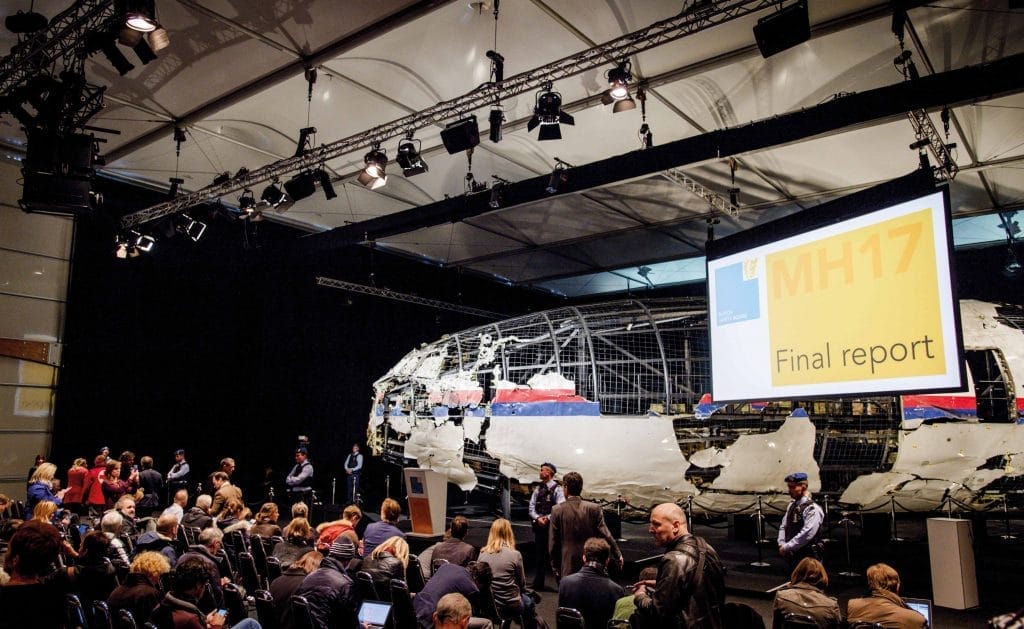
The final report on the cause of the crash at the Gilze-Rijen air-force base in the Netherlands, 13th October 2015. Photo: Emmanuel Dunand/AFP via Getty Images
It’s not just physical evidence that investigators have been working on, however. Although the opening court sessions in March covered mostly procedural issues, the prosecution also revealed for the first time that it would be presenting the testimony of several anonymous witnesses, including a person who was present when the Buk was launched. Known only as ‘M58’, to protect their identity, the eyewitness was a volunteer with the separatist unit that was guarding the Buk on 17th July 2014 and saw the fatal missile being fired.
It’s our obligation to fulfil this process for our beloved ones. To go to the end”
“It’s incredibly exciting,” says Higgins, who has been watching the court proceedings closely. “It’s great to see more levels of verification of our work, but it’s even better when there’s totally new information. That this kind of information is already coming up in the first days of court I think really speaks to how extensive this investigation has been and how much there still is to come,” he tells me. “The open-source stuff, I think it’s really going to be just the tip of the iceberg with this case. The conspiracy theorists who have said this is all just based on pictures off the internet are going to be shocked when they hear what the witnesses say in court and all the additional evidence that the Joint Investigation Team has gathered.”
In the security camera footage Anton Kotte can see his son, daughter-in-law and youngest grandson heading towards the airport gates. The couple are walking hand in hand and little Remco is clutching his teddy bear. “I can see that they are happy, excited for their big trip, but I know what’s about to happen,” he tells me.
On 17th July 2014, Kotte was among the relatives that got the devastating news: flight MH17 had come down and there were no survivors. The days that followed brought a whirlwind of emotions. Kotte remembers sitting in a hall full of next-of-kin as law-enforcement officials tried to explain the difficulties in accessing the crash site and repatriating the victims’ remains. “There was a lot of emotion in that room – anger, sadness. There were a lot of questions,” he recalls. It was in that moment of high emotion that Kotte made a promise to himself and the entire room. He stood up and addressed the crowd. “We as relatives, it’s our obligation to fulfil this process for our beloved ones. To go to the end,” he told them.
Despite his bold words, Kotte admits that at the time the idea that justice would actually be delivered seemed like a “very dim and distant dot on the horizon”. But he was determined to play his role. As a member of the board of the Air Disaster Foundation, an organisation set up by the MH17 next-of-kin to advocate for their needs, Kotte has done much to help the relatives over the years, including persuading the Dutch government to make the CCTV footage from Schiphol Airport available to those who wanted to catch a final glimpse of their loved ones. Now with the trial underway Kotte, who also lost his wife last year, says that the dot he imagined all those years ago is finally “getting much, much closer”. Still, he tells me, he’s aware that “there’s a long way to go yet”.
Although the court has scheduled an initial batch of sessions due to run through to the start of 2021, legal experts warn that it will likely take years for a verdict to be reached. Indeed, delay tactics may well form part of the defence’s strategy. None of the four accused, who are believed to be living in Russia or separatist-held east Ukraine, responded to summons to appear in court and are consequently being tried in absentia. However, in an interview with the Times in May 2020, Igor Girkin admitted that “inasmuch as I was the commander of the rebels and a participant in the conflict, I feel a moral responsibility for these deaths” while denying that his troops shot down the plane. And one defendant, Oleg Pulatov, a former Russian army officer, did appoint legal counsel to represent him shortly before the trial started. His lawyers have already asked for, and been granted, more time to review the 36,000-page case file and to get technical and forensic reports translated into Russian so that their client can understand them. Such requests are “reasonable” says Marieke de Hoon, an assistant professor in international law at Amsterdam’s Vrije University, because “the prosecution had nearly six years to prepare for this case compared to the defence having just months”. But she warns that the protections the Dutch legal system affords to defendants could be exploited if the three other accused men appoint lawyers at a later date.
“This is just speculation, but if the four accused were communicating, it could be really strategic as a delay tactic to send one defence team now, and then at certain strategic moments to add another and then maybe another,” she tells me. “It’s not a just case of ‘Oh hey, I didn’t show up and now we have to restart everything,’ but in principle under Dutch law the accused have rights that mean large parts of the trial could have to be redone or that the cases have to be split up and progress at different paces.”
Another possibility is that Pulatov’s legal team might try to mount a “rupture defence”. The strategy, made famous by lawyer Jacques Vergès in his defence of an anti-French Albanian guerrilla in 1957, rests not upon attacking the facts or evidence presented in court, but upon denying the very ability of the legal system to try the defendant; essentially, in this case, to claim that because the Netherlands is an interested party the Dutch courts cannot be a neutral arbitrator.
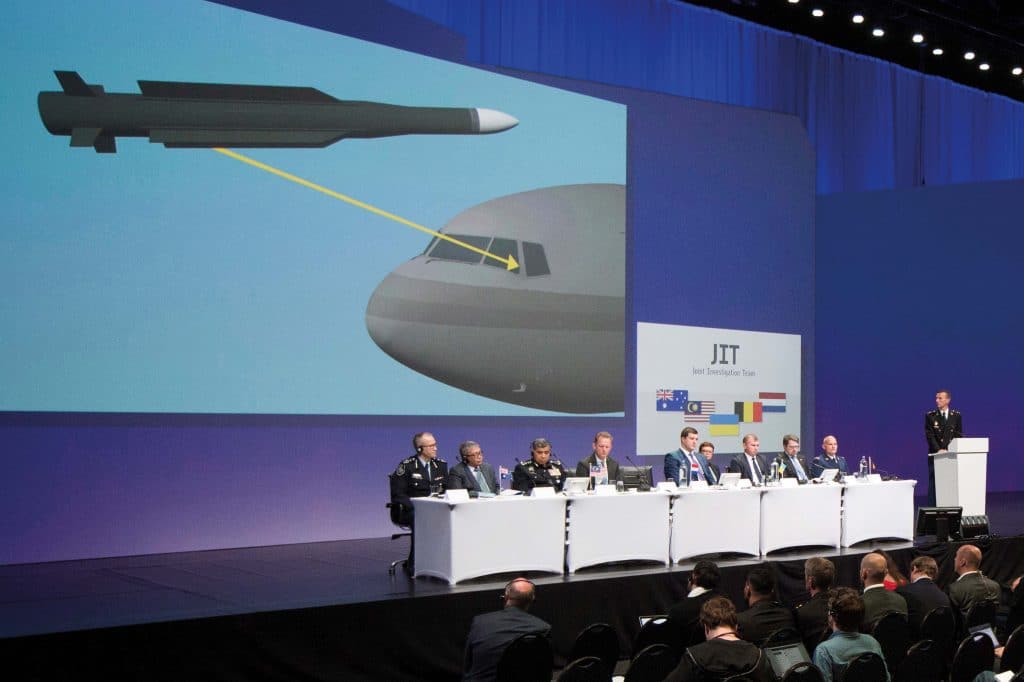
Members of the Joint Investigation team (JIT) present the preliminary results of the criminal investigation into the downing of MH17 in Nieuwegein on 28th September 2016. Photo: Robin van Lonkhuijsen/ANP/AFP
That MH17’s downing is being prosecuted in the Netherlands is not in itself strange. The country’s legal system has well-established rules, while setting up an international criminal court requires lengthy multi-party negotiations about which country’s laws will be applied, where judges will come from and even what sentences can be imposed. In addition, domestic legal systems also tend to hand out harsher penalties – murder in the Netherlands is punishable by life, whereas international courts frequently hand out much shorter sentences, even for horrific war crimes.
“I think it’s largely a pragmatic decision to try this case in the Netherlands,” says de Hoon. However in a case like MH17, which has substantial geopolitical ramifications, defence lawyers could, she says, try to “make proceedings into a show trial by focusing on the question of unfairness”. It’s a catch-22, she says: “If you have a trial with proper due process then you’re giving a platform to exceptionally good lawyers, who can put a lot of persuasive power behind these counter-narratives, and claim very publicly that it’s unfair and a show trial. If you diminish that space then it’s actually a show trial because you’re not giving the defence the right to do what they’re entitled to.”

The JIT reveal part of the Buk rocket fired at flight MH17, 24th May 2018. Photo: Emmanuel Dunand/AFP via Getty Images
Vergès’s original use of the ‘rupture defence’ failed and his client, Djamila Bouhired, was given the death penalty. But it also created such a public outcry that the state later granted her a pardon before the execution was carried out.
This trial, which began on 9th March 2020, is unlikely to be the last. The JIT has not ruled out indicting more people for their role in the downing of MH17 and legal experts say that if a conviction is secured in this trial prosecutors will probably look to bring to court more individuals further up the chain of command.
Indeed, in the opening days of the trial the prosecution not only pointed to Russia’s involvement but also to its persistent attempts to cover up what happened in the aftermath, including evidence that Moscow had attempted to conduct cyber-attacks on the computer systems of Dutch and Malaysian investigators. “This information casts a dark shadow over these proceedings,” prosecutor Thijs Berger told the courtroom. “There are strong indications that the Russian government is very keen to thwart this investigation and that it is not averse to deploying the Russian security services to this end.”
I think it’s really impressive that our small nation has delivered this, that they’ve taken on a country like Russia”
“It’s really quite remarkable to hear Russia, Russia, Russia, in what is a Dutch criminal legal case where the Dutch state is prosecuting individuals, not a state,” says de Hoon. “This could point to groundwork being laid for a case against Russia in the future. If judges accept these arguments it certainly could carry significant weight in future proceedings.”
Piet Ploeg, chairman of the Air Disaster Foundation, hopes that one day Russia will be held responsible, but he points out that it’s already a “remarkable achievement” that anyone is facing trial at all. “I think it’s really impressive that our small nation has delivered this, that they’ve taken on a country like Russia,” he tells me. “The JIT have been absolutely determined to bring this case to court, to carry out the investigation in extremely difficult circumstances, to do their absolute best to see that justice is served.”
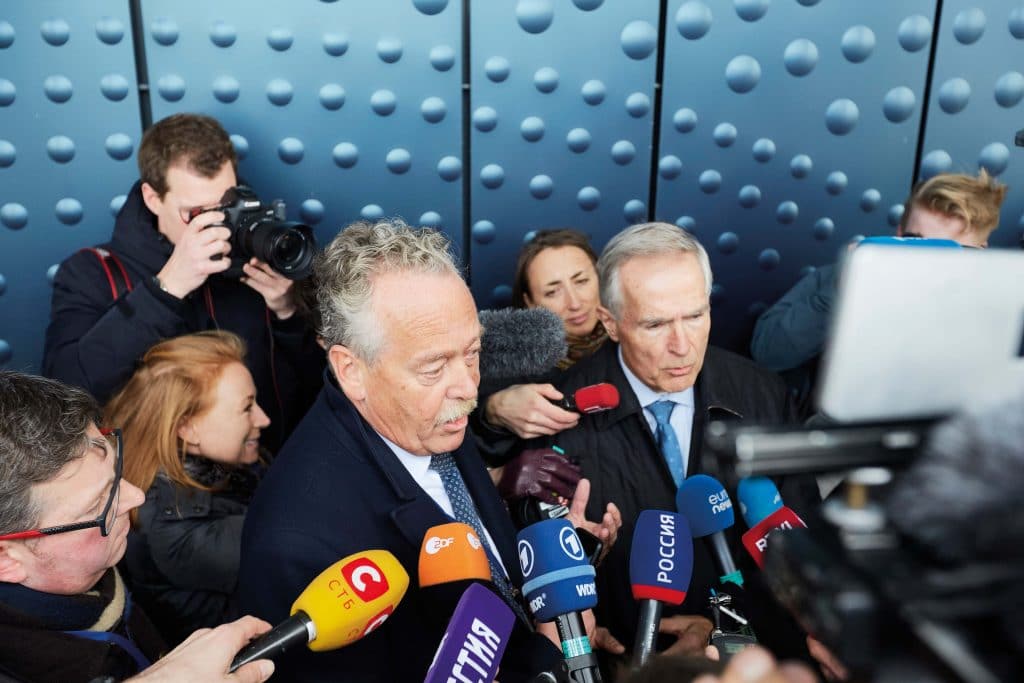
Piet Ploeg (left) and Anton Kotte of the MH17 Air Disaster Foundation. Photo: Pierre Crom/Getty Images
However, as he points out, no court case could ever be enough, or any sentence sufficiently severe, for those who lost loved ones. “We want justice. All the next of kin want justice, but it’s not the same as closure; I don’t like that word,” he tells me. Ploeg, like Kotte, chose to view the airport camera video of his brother and sister-in-law boarding the plane. He has it at home and from time to time will take it out to watch. For him it’s a precious memory. But not all his family feel the same. His brother is one of the only two victims of whom forensic investigators have been unable to locate any remains. Last year his mother died without being able to bury her eldest son. Neither she nor Ploeg’s two nieces elected to watch the CCTV footage. “I keep a copy for the girls in case they change their mind. But so far it’s just too painful for them,” he tells me. The eldest of his brother’s daughters is now pregnant and about to marry. “When her baby’s born, her parents won’t be there to share that moment. Her parents’ death will always be a part of who she is. So yes, we want justice, and of course it’s natural and healthy that the lives of the next-of-kin move on, but I don’t think that the trial’s end will mean this is finished. It’s not something that can be undone.”
Slow Journalism in your inbox, plus infographics, offers and more: sign up for the free DG newsletter. Sign me up
Thanks for signing up.

